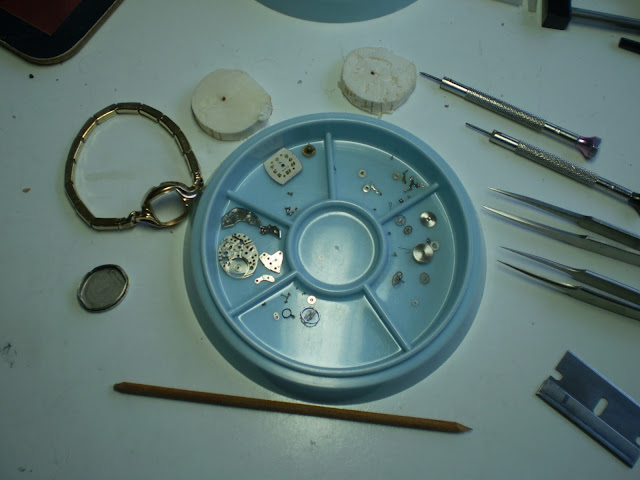One sees Elgins in A-11 cases with 24 hour dials on Ebay all the time. Often, the title of the listing will say "WWII", despite the fact that the movement is one that was not made until 1950, and the serial number dates it to the same time. Of course, since these are billed as 'military', there's always SOMEbody willing to pay hundreds of dollars.
While there is a FAINT possibility that some 24 hour Elgins, cased as wristwatches, the majority of what one sees are in fact Frankens. There were not large numbers of 24 hour Elgin wristwatches issued to the military.
The thing is, Elgin DID make 24 hour watches. Mostly, however, they did not make them for the wrist. They were, in fact, camera watches, used in gun cameras on jet fighters. These would allow a 'time stamp' in film from the gun camera. The Hamilton commonly known as the 'bomb timer' was used for much the same purpose.
Movements known to have been used for camera watches include two 8/0 movements (647 and 685), and a number of the 13/0 Durabalance movements. Other watch companies made similar watches - I've seen them with Bulova movements, and Rene Rondeau (Mr. Hamilton Electric) has a Hamilton 505 Electric movement in a camera case with a 24 hour dial, with the battery replaced by a wire that presumably went to the plane's electrical system.
Recently, I acquired an Elgin camera watch movement. It dates to the early 1960s, during the Cold War. It's a Durabalance movement, made especially for this purpose, with 24hr dial gearing and dial, and with hacking.
Here it is in a camera watch case I'd bought separately.
I cleaned it, replaced the 3rd wheel and sweep second wheel, and got it running. I decided to make my own Frankenized 24 hour A-11, so I bought an NOS Star A-11 case, which it fits perfectly.
HOWEVER, Elgin also made some 24 hour watches as wrist watches. I acquired one several years ago for $8. EIGHT DOLLARS!!! The seller listed it as a 'calendar watch', presumably because he didn't realize it was a 24 hour watch.
The movement, a 729, was introduced in the late 1950s as a 24 hour, sweep second, hacking movement. It shares pieces with the 730A B.W. Raymond Railroad wristwatch, and also with the 752, a 19j Sweep Second Durabalance movement.
After posting about it on a forum, Cary Hurt contacted me, saying he had a NOS dial just like this one, if I wanted it. OF COURSE I wanted it!
Today I COA'd the movement, and I wanted to share two features.
First, the hacking. 'Hacking' means the balance stops when the stem is pulled out to set the hands. This allows the watch to be set to the second, like in war movies - "Let's synchronize watches, men!" In the case of the 13/0 hacking movements, there's a simple spring which would normally rub on the balance rim.
When the stem is pushed in to winding position, the tip of the stem pushes the spring, lifting it off the rim of the balance and allowing the watch to run.
The spring goes OVER the 3rd wheel, which makes it a bit of a pain to reassemble!

The second special function is the 24 hour gearing. In a standard watch, the Center Wheel post carries the Cannon Pinion, which fits friction-tight, allowing it to slip while setting the watch, but tight enough that the turning of the Center Wheel turns the dial train and hands.
The Cannon Pinion meshes with the Minute Wheel, which carries a small pinion. This pinion meshes with the Hour Wheel, which slips over the Cannon Pinion. The hour hand mounts on the extended tube of the Hour Wheel, and the minute hand on the tip of the Cannon Pinion.
In order to get an hour hand that goes around once in 24 hours, rather than 12 hours, the gearing is changed, such that the hour hand turns at 1/2 the speed.
On the left you see the Minute Wheel (top) and Hour wheel of a 12 hour watch. On the right, the same pieces from a 24 hour watch. Notice the 24 hour Minute Wheel Pinion is smaller, and has smaller teeth than the 12 hour, while the Hour Wheel of the 24 hour watch is larger and has many more teeth than the 12 hour. This simple change is all that's needed to make a 12 hour watch into a 24 hour watch.
Here are my two 24 hour Elgins. The one on the left, the faux-military Frankenwatch, whle the one on the right is a genuine, non-military 24 hour Elgin wrist watch.






.JPG)

.JPG)
.JPG)











